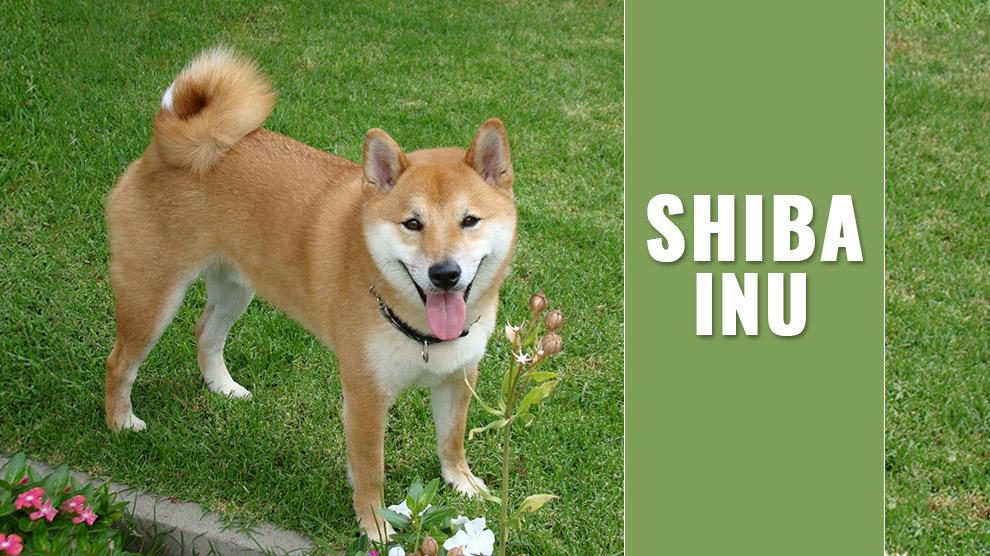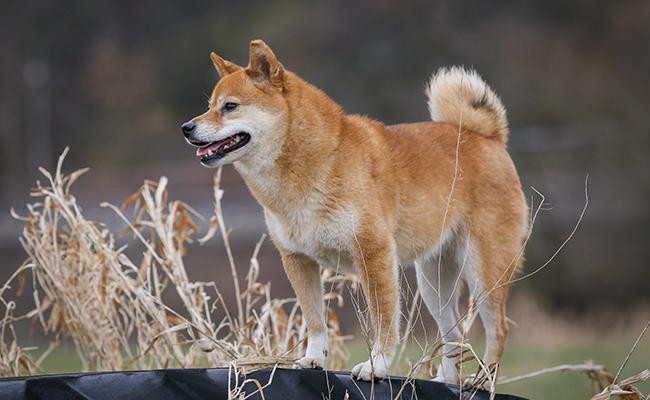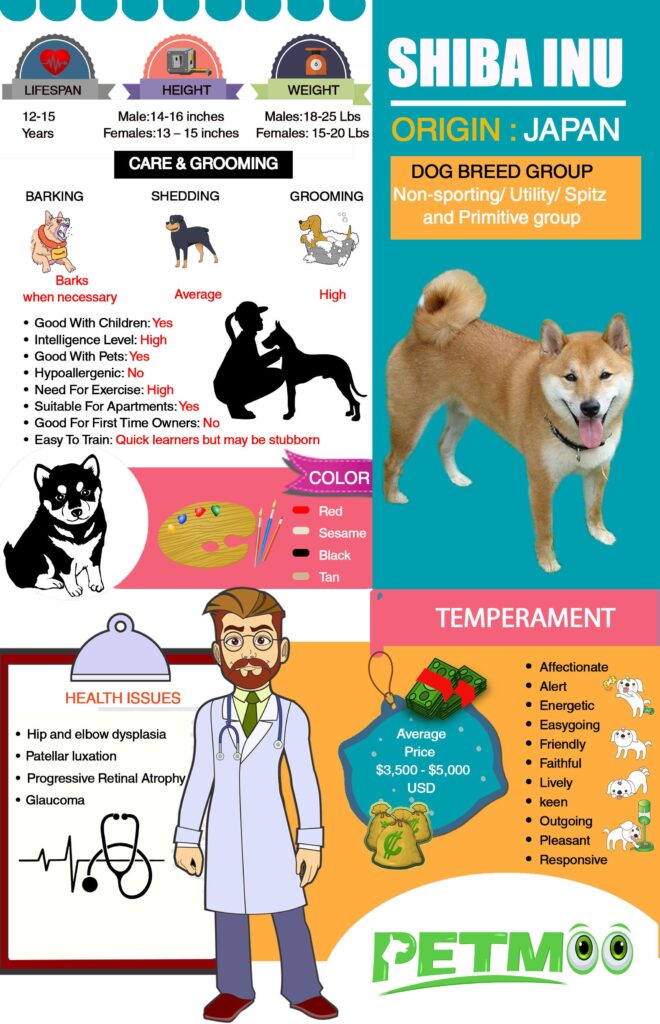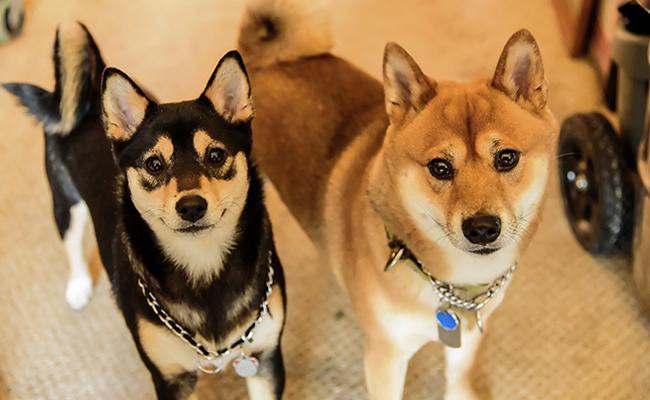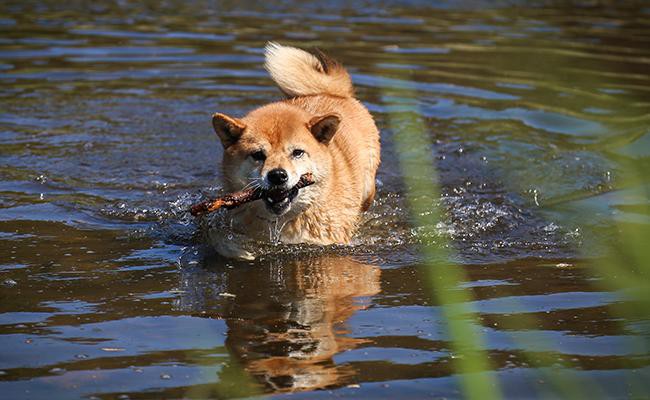Dog Pregnancy Calculator And Timeline
“OMG, it’s the Doge!” or “Is that a fox?”
You will be bombarded with many queries, compliments and sure to turn many heads while walking next to a Shiba.
Such swag, style, many fashions – says texts in multi-colored comic sans MS over the picture of a dignified, delightful looking extra floofy fox-dog with a diligent face but in a perplexingly hilarious Doge meme in Shiba-Instagrams.
Many people first became familiar with these endearing, eccentric Spitz dogs from the land of the rising sun from that ‘Doge’ meme that was everywhere for a while but, in fact, they are a very old breed that has developed quite independently from other common dog breeds of today.
He has everything the Best Dog in the World should have: practical, photogenic, pleasant, personable and, most of all, plenty. Well, actually…he is fleecy.
Shiba Inu Pronunciation:
So much, so that the meme-fraternity invented a whole new word just for them – a doge. Although the breed name, “Shiba Inu” (pronounced She-ba E-nu) isn’t very difficult to articulate once you’ve heard it, spelling, well… it’s a different matter.
Shiba Inu Breed Characteristics Sheet
- Origin: Japan
- Size: Medium
- Dog Breed Group: Non-sporting/ utility/ spitz and primitive group
- Purebred: Yes
- Lifespan: 12-15 years
- Height: Male: 36-41 cm(14-16 inches), Females: 33 – 38 cm (13 – 15 inches)
- Weight: Males 8 – 11 kg( 18-25 lbs) Females 6.8 – 9 kg(15-20 lbs)
- Coat Appearance: Soft double coat
- Coat Colors: Red, Sesame, Black, Tan
- Temperament: Affectionate, alert, charming, Energetic, easygoing, Friendly, faithful, keen, Intelligent, Lively, keen, Outgoing, pleasant, Responsive, spirited
- Good With Children: Yes
- Intelligence Level: High
- Good With Pets: Yes
- Hypoallergenic: No
- Grooming: High
- Shedding: Average
- Barking: Barks when necessary
- Suitable For Apartments: Yes
- Need For Exercise: High
- Easy To Train: Quick learners but may be stubborn
- Good For First Time Owners: No
- Health Issues: Hip and elbow dysplasia, Patellar luxation, Progressive Retinal Atrophy, glaucoma
- Litter Size:3 puppies on average
- Average Price: $800 – $1000 USD (USA), £1,557 for kc registered, £1,256 for non kc registered (UK)
Shiba Inu History
The Shiba is the smallest and, perhaps, the most ancient of the Japanese native spitz breeds (Hokkaido Inu, Akita Inu, Shikoku Inu, Kishu Inu, Tosa Inu, and Kai Inu).
The National Geographic states that Shibas are the breed that’s most genetically similar to wolves, suggesting that it’s among the oldest domesticated dog breeds and its origins are speculated to have begun more than nine thousand years ago.
However, on the record, the name- Shiba Inu was coined in the 1920s in Japan. Despite its smaller size, these little hunters were bred to hunt small wild game, deer, bear, wild boar and to flush birds
The Japanese people take great pride in the Shiba Inu and the breed was declared a national treasure in 1936 under the Cultural Properties Act.
Most of these dogs came from the San-In or Yamanashi areas of Japan. Shiba translates to brushwood or firewood bushes (some argue that it means small).
Therefore, it’s speculated that the hunting escapades of the Shiba in the brushwood bushes contributed to the name.
During World War II, the bombing caused the deaths of many Shiba Inus and other dogs in Japan. Even after the end of World War II, a Distemper outbreak in 1952 almost exterminated most of the Japanese breeds.
After nearly going extinct, several breeding programs by the Japanese bred the three remaining bloodlines: the San-In Shiba, the Shiba Shu Shiba and the Mino Shiba together to bred what is at present the modern-day Shiba Inu
The first Shiba arrived in the United States in 1954, brought by an American soldier from Japan. The first litter was born in the United States in 1979 and American Kennel Club finally officially recognized the breed in 1992.
At the moment, Shiba is the 46th most popular dog in America.
Shiba Inu Coat Color And Appearance
Shiba Inu Coat Color
- Red
- Sesame
- Black and Tan
Double-coated, with the harsh and straight outer coat; soft and dense undercoat with hair on tail slightly long and standing off (forming a bristle, not a plume)
Red – This is the most common and well-known color. Light red to deep orange-red.
Black and tan – The black Shiba rusty cast (not blue) and tan markings in the parts of the body. There is also multicolor coat combines black, fire-engine red and white.
Cream Coat – Pale golden coats- although they are not standards, they look very similar to red Shiba but the intensity of the coat color is really softer (it’s a pastel shade)
White coat – You may be surprised to see a white coat Shiba, however, the AKC considers this as a major fault. The British Kennel Club accepts white as a breed standard.
Sesame – Three types of sesame Shiba Inu
Sesame – Black, red and white hairs in equal proportion.
Black Sesame – Lots of black than white hairs.
Red Sesame – the Basic color of hair is red, mixture with black and white hairs.
All these above-mentioned colors must have “Urajiro” (creamy white ventral color).
“Urajiro” = Whitish coat on the muzzle sides and on the cheeks, inside ears, on the underside of the jaw and upper throat, on the chest and abdomen, around the vent, on the inside of the legs and the underside of the tail.
Shiba Inu Appearance
Small sized, compact dog, just off-square, well proportioned, well boned with well-developed muscles. Strong Constitution, quick action, elegant and beautiful. The height at withers to length of body ratio is 10: 11.
Facial region
Broad, level skulls and properly muscled cheeks with a moderate stop and an attractive furrow. The straight muzzles taper slightly at the nose (40% of total head length).
Tight lips and black noses while some white dogs have flesh colored noses which are also acceptable as a breed standard. Small, triangular shaped eyes that are set well apart on a dog’s face (slanting up at outside) being a nice dark brown in color.
Thick, small, well-furred Ears which the dogs carry pricked and inclining forward. The shibas have a strong jaw with a perfect scissor bite
Body
Slightly arched necks which are moderately long and are very well-muscled. They boast moderately sloping shoulders and no dewlap with well-developed forecasts with their front legs being straight and strong.
They have level backs, short loins, and quite high, well-developed withers. Deep chests with moderately sprung ribs. The nicely tucked up bellies add to the Shibas’ agile appearance.
Powerful Back legs with long upper thighs and strong, but short second thighs. cat-like feet with well-arched toes, thick, elastic pads, and strong dark nails.
Tails are set on high and carried vigorously curved or curled( like a sickle), the tip nearly reaching hocks when letting down.
Shiba Inu Mix Breeds
- Papillon mix + Shiba Inu = Papi-Inu
- Pomeranian mix + Shiba Inu = Pom-Shi
- Miniature Pinscher mix + Shiba Inu = Shiba Pin
- Dachshund mix + Shiba Inu = Shibadox
- Poodle mix + Shiba Inu = Poo-Shi
- American Eskimo mix + Shiba Inu = Imo-Inu
- Pug mix + Shiba Inu = Pug Shiba
- Boston Terrier mix + Shiba Inu = Shibos
- Cairn Terrier mix + Shiba Inu = Shairn-Inu
- Miniature Schnauzer mix + Shiba Inu = Schnu
- Shetland Sheepdog mix + Shiba Inu = Sheltie Inu
- Chihuahua mix + Shiba Inu = Shiba-Chi
- Cocker Spaniel mix + Shiba Inu = Shocker
- Siberian Husky mix + Shiba Inu = Siberian Shiba
- Beagle mix + Shiba Inu = Shi-Beagle
- Cavalier King Charles Spaniel mix + Shiba Inu = Cava Inu
- Welsh Corgi mix + Shiba Inu = Shiba Corgi
Shiba Inu Size And Lifespan
Shiba Inu Size
Height
Male – 36-41 cm(14-16 inches), Female – 33-38 cm(13-15 inches)
Weight
Male – 8-11 kg(18-25 pounds), Female – 6.8-9 kg(15-20 pounds)
Shiba Inu Lifespan
A healthy Shiba Inu should expect to enjoy a life expectancy of between 12 – 15 years, sometimes as long as up to 16 years old, when properly cared for and fed a good quality diet to suit their ages.
Shiba Inu Temperament
Pros
- Kan-i, Ryosei, Soboku – These three qualities used to define a true Shiba dog by the great people of Japan.
- Kan-i – means “spirited boldness” and also “well-balanced, courageous and signifies its strong- independent nature.
- Ryosei – He is subdued, kind and loyal which makes him an ideal home guardian. A Shiba that have good kan-I cannot exist without good ryosei
- Soboku – This is not as much a trait, however, it is more a way of manifestation. With Soboku, the Shiba reveals his refined simplicity, elegance and natural beauty which he has acquired by seasoned maturity.
- Simply put, Soboku is “unadorned natural beauty” or “artlessness”. Oops, still not sure what Soboku means? Take a look at the modern-day dog breeds like the Spaniels, pugs, the Poodle, Yorkies etc.
- Yes, they are indeed beautiful dogs with wonderful, flamboyant personalities. However, they are very showy and “ostentatious”. On the other hand, a Shiba has an unpretentious look! You can’t read the innate loyalty, boldness and obedient personality of the Shiba.
- Shiba is often referred to as being a huge dog in a little dog’s body and they are really affectionate, kind dogs that are not known to be so aggressive
- He is a bold, hard nut, spirited little wild thing, good-natured scamp… you will sure to love him just the way he is.
Cons
- Shiba is a natural born pack leader and he is an instinctively an alpha dog in a household right from the word go. Though he is an intelligent dog, make sure to curb his dominant nature and acclimatize him with their place in the pack (household).
- Shiba is, instinctively- independent dogs! These dogs are not cuddly nor are they clingy. If you’re looking for a cuddly pooch who’ll crave your attention, then the Shiba may not be right for you.
- They are incredibly inquisitive little dogs and have some odd cat-like traits much like their cousins, the Japanese Chin. Shibas are curious, stubborn, strong-willed just like cats.
Adaptability
- Apartment Living – Yes
- Good For First-Time Owners – No
- Sensitivity Level – Average To High
- Loneliness – Yes
- Cold Weather – High
- Hot Weather – Average
Friendliness
- With Family – High
- Kids – High
- Other Dogs – High
- With Cats – Moderate, If Raised Together
- Other Pets – Moderate, If Raised Together
- Strangers – Suspicious, Reserved
General Behavior
- Independence – Independent
- Dominance – High
- Combativeness – Bit Aggressive
- Indoors – Moderately Active
- Outdoor – Highly Active
- Territorial – Yes
- Easy Of Transportation – Medium
Shiba Inu Care
- Exercise Needs – Fairly High
- Intensity – Medium
- Activity Level – Medium
- Exercise Requirements – >60 Minutes/Day
- Walk Mileage/ Week – 8 Miles
- Playfulness – High
- Grooming Needs – Average
- Tendency To Drool – No
- To Snore – No
- Bark – High
- To Dig – Low
- Social/Attention Needs – Low
So, what about the first-time owners?
Shiba is not the best choice for First-time dog owners as they need to be trained, socialized and handled by people who are proficient with the specific needs of smart, stubborn and sharp dogs.
They can often let slip a more dominant side so they need to be appropriately handled and trained right from the outset. They are capable of learning a great deal and are eager to impress but they can be manipulative as well.
You should be consistent and keep your training sessions short and interesting. Siberian shepherds are also so shrewd that if you make any harsh, insensitive corrections, they may stand firm and become even more resistant.
First-time owners, if they do want to get one, they must know that they are dealing with an alpha dog and may be difficult to train, so decide to adopt this Japanese handsome only if you are willing to put in the effort.
Make sure to probe into their outlook extensively before adopting. Do not become unsettled by them and make yourself the leader of your pack.
Shiba Inu Food
Shibas are, of course, small to medium-sized dogs but are highly active and energetic. They need just the right balance of nutrients and protein-rich diet to accommodate all that activity.
They will thrive on a varied, fresh human grade food that has a balanced amount of protein, fat, and carbs. Although most vets still recommend commercial “kibble”, there is a rising movement to keep away from commercially processed foods.
Try to mix and match a few different dog food brands before committing to one so that you can find a flavor or brand your dog just loves so that you can stick to it.
As a general rule, they eat dog food made for small or medium breeds, 3-4 cups divided into two meals, depending on the health requirements and the dog’s age.
You will need to take their activity level into consideration when determining how many calories your dog needs, particularly if you are doing any work or training.
Choose highest-quality dog food with different kinds of flavor enhancers to excite your dog. Don’t avoid moist foods (generally canned foods) because they like to nosh-up and are easier to digest.
It’s better to avoid commercial food or store-bought dog food for your pooches, as the quality of their diet will have a major impact on their health, growth and their shiny coat appearance.
Add venison one day, crumbled treats like freeze-dried liver another time and wet food- chicken the next!
Rough Feeding guide for Shiba Inu dog:
Meal frequency for Shiba
- First 1-3 months: three meals per day
- After the third month: two meals per day
Remember the formula = (Weight (Kgs) X 30) + 70 = Daily caloric intake.
For instance, a male Shiba which weighs 10 kg, therefore would require: 30 X 10 kg +70 = 370 Calories per day
- Average Daily Cost – $1.20 – $1.40
- Monthly Cost – $34.00 – $45.00
- Pups between eight and 12 weeks old – 3 meals every 24 hours (120g- 200g).
- 3 to 6 months old – 2 meals daily (200g)
- Feed puppies 6 months to 1 year – 2 bowls of food daily (200g)
- When your puppy hits his first birthday, one or two smaller bowls/ 24 hours is typically all that’s necessary.
Remember, the feedings depend on your puppy’s build, eating affinities and on their activity level.
- Dogs 8 kg =120g
- Dogs weighing 9 kg = 140g
- Dogs weighing 10-11 kg = 160g
Adult dogs need to be fed a good quality diet that meets all their nutritional needs while keeping a close eye on a dog’s weight.
Here is a rough feeding guide for you to glance through.
- Protein content should be anything from 30%
- Carb content should be 30 to 65%
- Fiber content should be less than 4%
- Fat content should be less than 10%
- Calcium content should be 0.5 – 0.8%
- Phosphorous content should be 0.4 – 0.7%
- Sodium content should be 0.2 – 0.4%
These are favorite foods that should be fed to Shiba:
- Lean beef
- boiled chicken
- wild omega-rich fish
- brown rice
- okinawan sweet potatoes
- papaya
- cantaloupe
- spinach and broccoli
- lettuce and carrot
- Bread Dough and Salty food
Shiba Inu Training
- Trainability – Quick Learners But May Be Stubborn
- Intelligence – High
- Memory – High
- Mouthiness – Low
- Prey Drive – High
- Wanderlust Potential – Average
Is a Shiba hard to train?
- A Shiba Inu always approaches the world with a calm dignity so he must reflect his majestic personality in the way he carries himself which is likely why he is also described as stubborn.
- Because of his independent nature, the Shiba Inu is not the easiest breed to train. During the training, he is more likely to use their wits to their own end. Shiba is a good family dog and does well with children provided that he should be properly socialized and trained.
- He can learn commands and tricks very quickly. Despite the fact that he is an intelligent dog and motivated to learn, he needs a firm and consistent trainer/ owner to inculcate proper canine manners. When there is no proper training, owners may find it quite hard to handle him as he grows up.
- Sometimes there can be a streak of stubbornness in them but you just need to be consistent and make sure to establish yourself as the pack leader. For best results, it’s essential to work with a trainer who understands the breed’s independence, territorial nature, and possessiveness.
- Start the socialization and basic obedience training with him from puppyhood and include a variety of dog toys and treats to retain your dog’s interest.
- Getting outdoors for some action is also important to a Shiba as they will nit-pick at your toes and so forth, dogged to get you off your languor and turn into superman-mode.
- He needs a good daily workout, whether a jog alongside his bicycling owner or it’s a walk in the neighborhood. He is best suited to a household with a securely fenced yard to run amok. They cannot be trusted off leash as he has escape-artist tendencies.
- The breed is not innately very destructive, but Shiba puppies chew like there’s no tomorrow. Once they’re through the puppy stage chewing will fade away gradually to a sporadic snag, which you should provide any way with socks, shoelaces, tennis balls and so on.
- Shibas can be an expert accomplice on hikes and he will be sure to focus on his job and this satisfies his inner Indiana Jones. More importantly, it helps him burn off more of that built-up energy.
- Keep in mind; it’s essential that you start training at a young age. This can help ward off moments of bad behavior. Shiba puppies should be exposed to other dogs early on so that no authority issues surface in the future.
Shiba Inu Grooming And Shedding
- Coat Density – Normal
- Length – Medium
- Texture – Straight
- Brushing Frequency – Weekly Twice
- Trimming/Stripping – No
- Hypoallergenic – No
- Shedding – Moderate
Shiba’s double coat consists of the stiff, coarse, shorthaired outer coat while the undercoat is typically much short and fluffy. This needs brushing at least twice a week to keep it in top-notch condition, maybe more often during molting season.
However, Shibas are not actually the heaviest shedding dogs but dwell in the middle category. They are average shedders, which mean that they aren’t hypoallergenic; someone with allergies wouldn’t be very fine with a Shiba.
They do “blow their coats” particularly around shedding seasons. During this time, you can expect a Shiba with a moth-eaten appearance. Rest easy, The Shiba Inu is rather easy to maintain when it comes to grooming. He is, of course, hygienic and odor-free dog.
It is essential you brush your dog’s coat twice in a week, most importantly, during season shift periods. Brushing the dog’s fur keeps it healthy, tangle-free and maintains the natural sheen.
Shiba Inu Health Problems
Major health problems in Shiba Inu include:
Hip and Elbow dysplasia – They are the common, complex multifactorial, genetically influenced disorders found in dogs. A developmental disorder of hip and elbow joint which results in loose and unstable joints and damage to the cartilage surface of the joint – which often develops into painful arthritis and hip dysplasia.
Progressive Retinal Atrophy – An inherited disease occurs mostly at his twilight years, or at older ages that includes several different genetic diseases that lead to the degeneration of the retina.
Allergies – Food Allergies, inhalant allergies by airborne pollens, Dust mites, contact allergies such as Flea and tick bites, dog shampoo, bedding or due to chemicals
Minor concerns
Hypothyroidism – Hypothyroidism is the most commonly diagnosed hormone disorders in the dog which is a congenital disorder of thyroid gland, causing slow physical and mental development.
Glaucoma – Eye condition caused by an abnormally high amount of pressure due to inadequate drainage of aqueous fluid that builds up in the eye which will eventually cause permanent damage to the optic nerve, resulting in blindness.
Patellar Luxation – This is a common orthopedic problem in dogs in which their patella (kneecap) moves out of its normal anatomical location outside the femoral groove when the knee is flexed which will eventually rupture their cranial cruciate ligament.
Shiba Inu Price And Breeders
Shiba Inu Price
You should expect to pay $800 – $1000 USD. Some can go up to$1000 USD for depending on the pedigree, vaccine details, and the breeder. Always make certain to buy your dog from a reputable breeder or look at local dog shelters.
Shiba Inu Breeders
The best way to get started is by searching for a good breeder on national kennel or breed clubs. As with all hybrids, the cost of these pups often depends on the breeder and the availability.
Also, don’t forget to look for rescue groups in your state and let them know what you are looking for in the event that they know of an eligible Shiba available for adoption.
Top breeders of Shiba Inu in the US
- Marma Farms Fruithurst, Alabama
- Anderson’s Shiba Inus Miami, Oklahoma
- Icewind Shibas Phillipsburg, New Jersey
- Des Mar Shibas Redding, California
- Shiba Inu Louisville, Kentucky
- Pendragon Shibas Dodge City, Kansas
- Innisfree Kennel Welcome, Maryland
- Tintown Shibas Dover, Ohio

